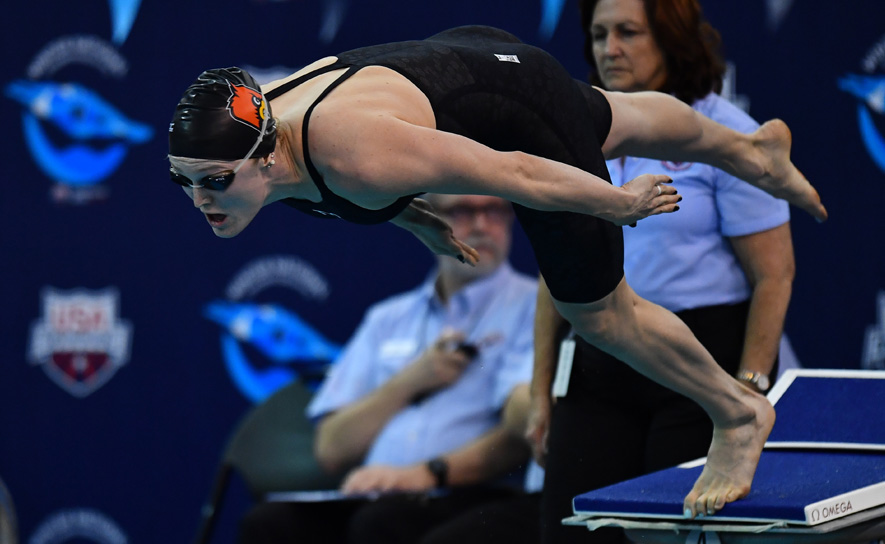USA Swimming News
What it Really Means to be "In The Moment"

by Mike Gustafson//Contributor
Growing up as a competitive swimmer, I often heard from coaches about the importance of “being in the moment.” Coaches would say, “Mike, you have to learn how to stay in the moment.” And I’d be like, “I am staying in the moment.” Then I’d start thinking about the upcoming race, feeling jitters in my stomach, worrying about losing the race…
And of course, I wasn’t at all in the moment. I didn’t even know how to get there, much less stay in it.
Also growing up, I heard stories from older swimmers who experienced “painless” races — races where they had sort-of like out-of-body experiences. This painlessness seemed contrary to being “in the moment.” After all, I assumed that if I was “in the moment” of a 400 IM, then I’d feel all that pain that would accompany that race. But some swimmers, after performing a personal best, explained they felt no pain — like they were watching themselves perform. That the race "felt great.” I couldn’t believe how any 400 IM could feel great.
However, hundreds of races later, I understood both experiences weren’t all that different from each other. Attachment and detachment; staying in the moment and being completely outside the moment. Eventually, I learned that during races, being “in the moment” while also being “out of body” complimented each other. They co-existed. For example, I remember swimming a 200-yard breaststroke and earning a best time. In that race, I remember feeling both detached and immersed. I didn’t feel pain. And yet, I felt every stroke with clarity and calmness. I was completely self-aware, and yet, I wasn’t fixated on hyperventilating and painful strokes and counting down the last kicks until the wall.
Being “in the moment” — to me — doesn’t mean being so immersed inside of a moment that you feel everything. After years and years of trying to figure out what being “in the moment” means, I figured out that, to me, it means clarity. Having clear eyes (re: clear goggles) and a clear vision of what one needs to do to perform. It means forgetting about the stands, the coaches on the pool gutters, the teammates behind the blocks. Instead of immersing one’s self in the cheering, pressures, and hype of the moment, being “in the moment” means clarity, and the best way to gain clarity, for me, was one process:
Simplification.
When stepping up to the blocks, what is the simplest mindset? Swimming is a simple sport, yet we often override our hard drives with all kinds of “other” thoughts: Thinking about tomorrow’s upcoming test, or about how your parents are in the stands, or how you have to achieve a certain time, or you won’t get into this college you want to attend… That’s not a simple, clear mentality. “Over-thinking” is a term used to describe mental head-spinning thoughts. Thoughts about pressure. Thoughts about teammates. Thoughts about competitors.
Simplifying these thoughts can bring a swimmer back into the moment. When you’re about to race, the simplest mindset is best:
What do you need to do in the dive?
And then, once you dive in, what do you need to do in the breakout?
And then when you approach the turn, what do you need to do?
And so on.
Practice helps swimmers stay in the moment — especially when a competitor accelerates past you. Whenever I saw a competitor charge ahead in the lane next to me, that was also the time when I experienced pain. An ache in my stomach. A pain in my legs. I began to think, “Well, there goes the race. There goes all my training.” Conversely, when I was out in front, I hardly felt pain. In those races, I stayed in the moment, concentrating on the next stroke, the next kick, the next turn.
Learning how to stay in the moment can take time, but like anything, it takes practice. If you’re having trouble learning how to be and stay “in the moment,” try simplifying your thoughts during long sets. Focus on the body — on the pitch of your hands and flutter of your kick. This is a form of mental simplification. Stay with those body motions, think about them, and temper down those “other thoughts” — thoughts like, “How much more time until practice is done?” or “I would prefer to be sleeping right now.” Practicing focusing on the body and thinking about each upcoming task can bring about mental simplification that can, in my experience, lead to being “in the moment” over and over again.
Staying in that moment — simplifying thoughts, simplifying pre-race approaches — can then actually mimic those best practices and performances…The races when you’re one with the water with perfect clarity and mindfulness. So that each time you step on the blocks, you return to that simple, clear mindset. You can let go of all those external thoughts and find the best form of your performance-self.
So, the next time your coach or teammate suggests for you to “stay in the moment,” try simplifying.
Simplify thoughts.
Simplify objectives.
After all: The sport of swimming is simple: There are two walls and you need to swim as fast as you can between them. Every other thought — teammates, pressures, tests, schools, social obligations, the future and the past — only takes mental energy away from that objective. In reality, there are only two things to focus on: There is a lane. There is you.
Ready, set, be in the moment.
